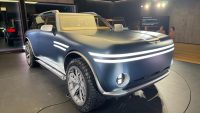The Tesla Model 3 is the UK’s most efficient new EV, according to a new survey by What Car?.
The consumer champion has been conducting its latest round of real-world range testing, which sees how far models can actually travel on a single charge.
The study saw What Car? fully charge the batteries of several EVs before seeing how well they use the electricity stored within them,
The most efficient new car in the test was found to be the Tesla Model 3 RWD, which averaged 4.4 miles per kWh, with a range of 255 miles.
By contrast, the the least efficient model to be put through the ringer was the the Audi Q6 e-tron Launch Edition, which managed only 3.0 miles per kWh against a range of 289 miles.
As a result, if you charged exclusively at home and paid 22.4p per kWh – the current electricity price cap – , you’d spend roughly £508 on electricity every 10,000 miles in the Model 3, versus £745 in the Q6 e-tron.
Meanwhile, if you were to exclusively use rapid chargers on the public network, costing 79p per kWh, those bills would rise to £1,795 for the Model 3 and £2,633 for the Q6 e-tron.
Speaking about the importance of efficiency, Steve Huntingford, editor at What Car?, said: ‘Only a few years ago, when electricity was cheap and any electric car cost far less to run than an equivalent petrol or diesel model, efficiency didn’t seem to matter that much.
‘However, with energy prices high and due to rise further, it’s now an important consideration.’
When looking at range alone, the Polestar 2 Long Range Single Motor came out on top, travelling an impressive 333 miles on a single charge – enough to get from London to Nottingham and back again without stopping.
The result placed the Swedish EV just ahead of the Renault Scenic E-Tech Long Range Techno, which managed 322 miles.
At the other end of the spectrum, the Mini Cooper SE Exclusive was only able to get through 211 miles on a single charge.

In addition to 11 new electric cars, What Car? also tested a nine-year-old Tesla Model S with 258,000 miles on the clock to see if concerns around battery longevity are justified.
Despite it still being on its original battery and effectively having been to the moon, the test showed the Model S had lost just 8% of its original capacity.
The testing was carried out at the Horiba-MIRA proving ground in Warwickshire. In each case, the climate control system was set to 21deg and Eco (or the closest equivalent) driving mode was selected.
The car were then repeatedly driven around a 19.2-mile test route, which included 2.7 miles of simulated stop-start urban driving, 5.5 miles at a steady 50mph and 11 miles at a constant 70mph.



































